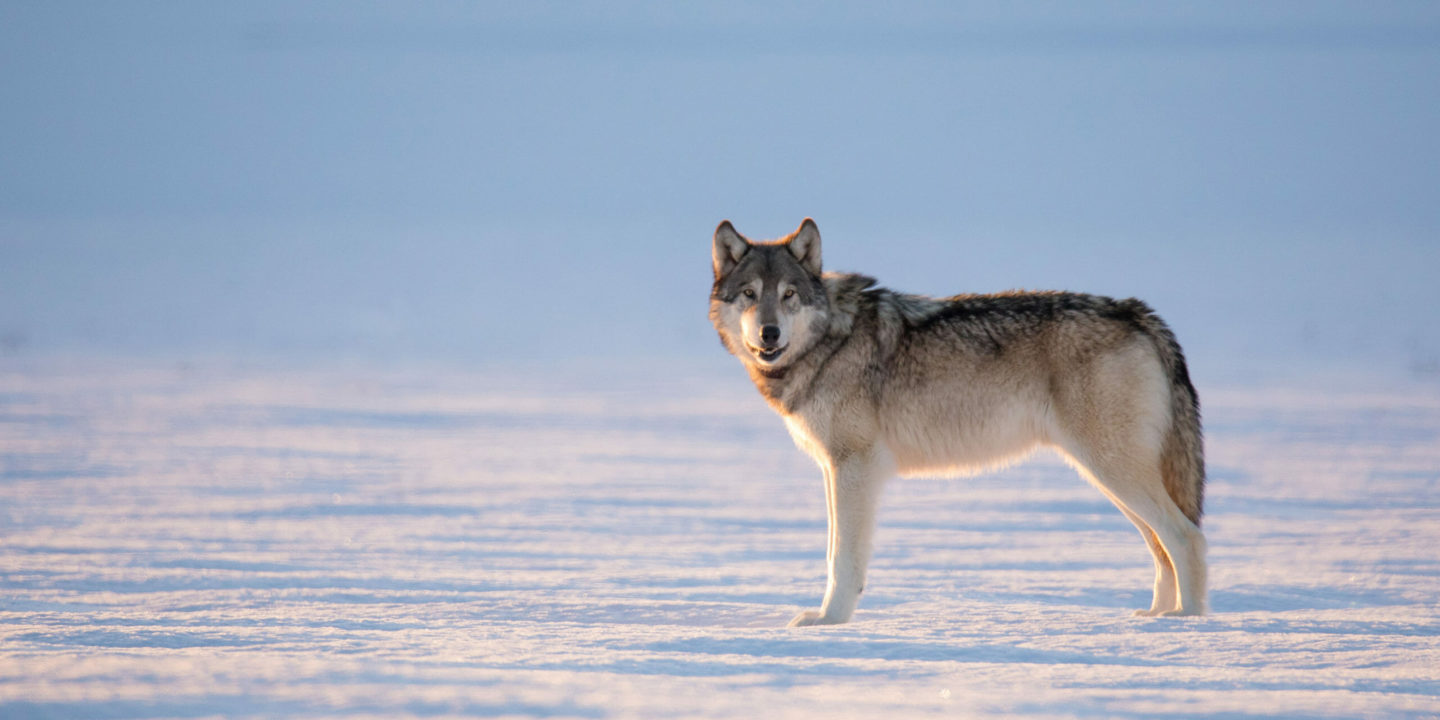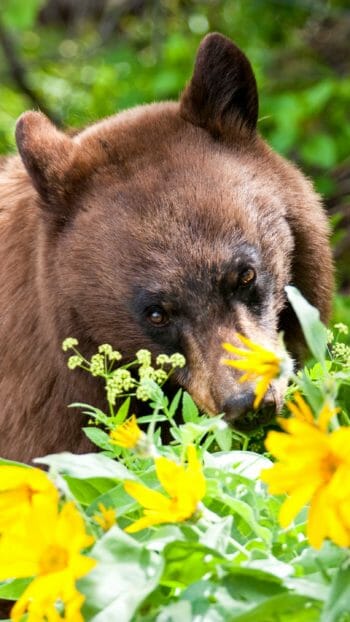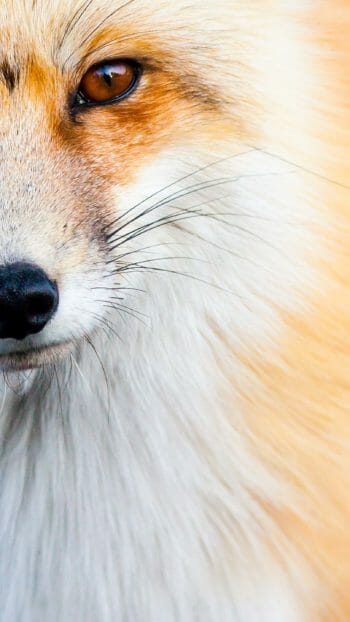Where To See Wolves in Yellowstone
Northern Range, Yellowstone National Park
On a cold bright morning in Yellowstone’s Northern Range, four guests and I were on the search for the wild gray wolf. The morning began full of silence, the kind of quietude known well to those who live in the thick of winter and far from humanity. This silence is foreign, and almost eerie, and winter is challenging for most humans. But out in the wild it is a time of power for the wolf. It is the time when we see their full character come to life. They become invigorated with an energy to survive. They mate, play, carouse, confront, hunt, and kill. Their pack dynamics shift dramatically. There are deaths and births and drama. To our benefit, this all becomes very visible against the vast blanket of white snow. With that in mind, we left Gardner, Montana just as the first morning’s light touched 11,000 ft Electric Peak with a deep orange glow, and headed south towards the place where one of North America’s apex predators thrives.
Not long into our drive we entered a wide-open plateau surrounded by impressive mountains both jagged and massive. An incredibly large wilderness stretched out in all directions. The sun’s light raced across ground in earnest bringing the vast rolling plains to life with light and color. The sky above was wide and clear and pulling the light towards it eagerly, becoming bluer and bluer and bluer. We stopped the car to admire the moment.
The moment we stepped out of the car we heard a sound breaking through the frozen air. A long, deep, mournful baritone which crawled out from the east and saturated the valley. It was incredibly loud against the stillness, and it was impossible not to react. The hair on the back of our necks raised up. Chests tightened. Breathing quickened. Rush of adrenaline.
It was a sound of the wild of antiquity, of a land before us. A sound you hear in movies, but never in modern life. Everyone was excited as we searched for the origin with our binoculars.
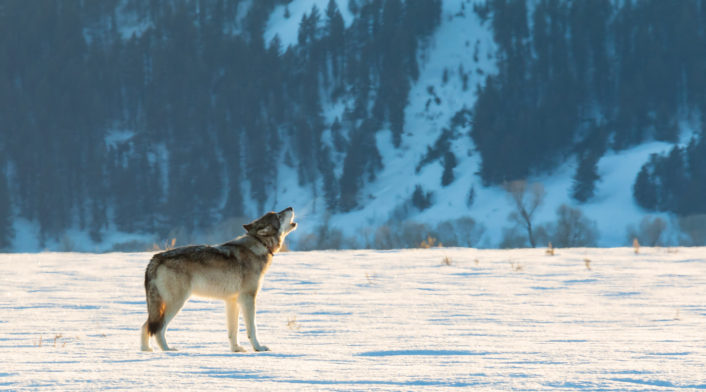
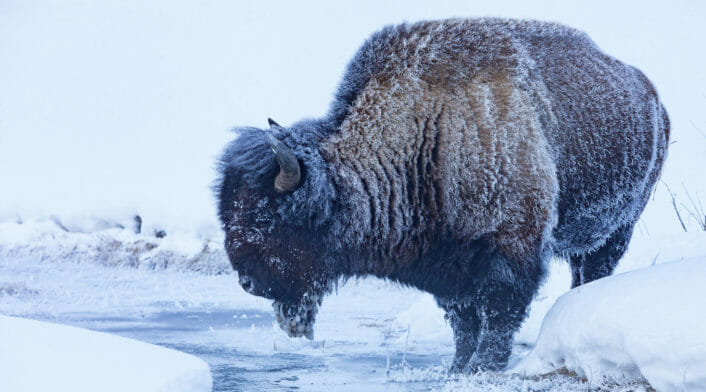
Immediately we saw it, a lone wolf traversing a sage-covered hillside. It was noticeable even at a distance, with a salt and pepper coat dark enough to stand out against the snow. It stood tall on long legs, with a thick tail lifted straight as an arrow from its back as it loped along with the tell-tale gait of its kind. It stopped, sniffed, dug a little in the snow, lifted up and howled again. It took half a second for the sound to reach us. The wolf turned a circle, marked, howled again, and started into a trot. We watched the canine intently for fifteen minutes as it meandered the hill curiously, repeating this behavior, continuing to howl every few minutes, and collectively pondered the meaning of his call.
In many ways, wolves are not like other wildlife. They stand apart in their intelligence and dynamism. They are one of the only mammals in North America to have a requisite family structure similar to that of humans. For most wolves, the pack is greater than the sum of its parts. They desire the company of their kind and show contentment with play and affection. They are driven by communal hormone surges that dictate care for pups and pack protection. They are also formidably aggressive and action oriented. Relationships between them form and dissolve often. Like with humans, there are also outliers, and about 15% of Yellowstone’s wolves are “lone”. These wanderers choose to live away from packs, but they cannot escape their nature forever. No matter their status, each wolf exhibits a discernible voice, a unique personality, and a particular effect on other wolves.
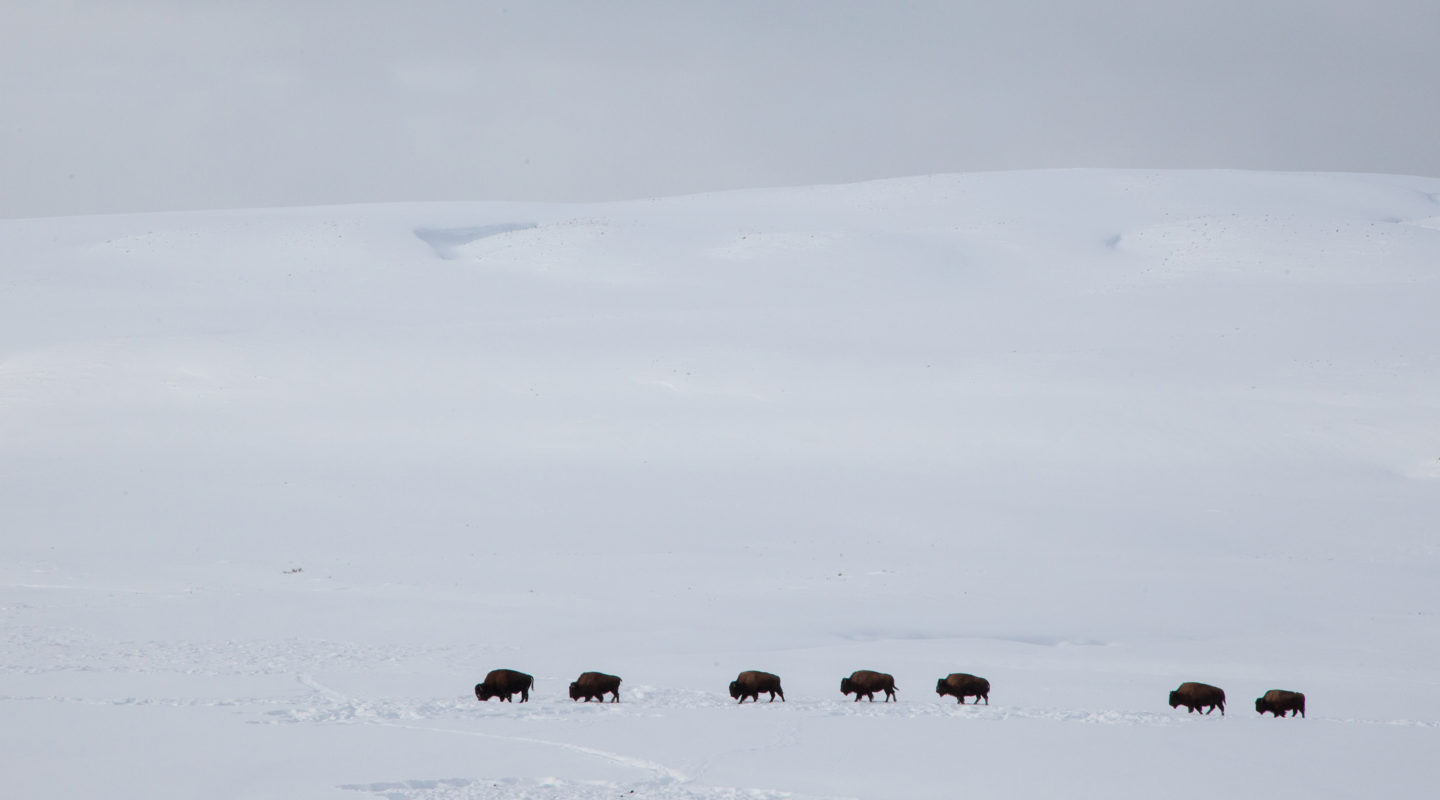
As we listened to the lone black wolf howling, wondering still what he or she might be saying, another howl surprised us from the hills to the southwest. This voice was softer, lighter, with a tonality like that of a Swainson’s thrush, rising higher and higher until almost twinkling. It was soon met with many voices, too many to discern. It was as if the whole world was howling and we were somehow caught in a vortex of sound. We glassed in our binoculars and were astonished to see an entire pack of wolves cresting an open ridge currently occupied by a herd of bison. We soon counted 18, and they were led by a white wolf around whom the bison gave a wide berth. I knew from this fact alone that they were the Wapiti pack, whose alpha is a formidable female descendant from some of the most famous female wolves in the Park, the Druid line. The Wapitis had been seen all winter in the area of Old Faithful, nearly 40 miles away. We could only guess as to why they had ventured this far north.
Before too long, our question was at least partially answered. The alpha female lay down on the ridgeline and two other wolves consorted her. We could see their tales wagging, their necks dropping in submission, and even a tender nuzzle to her nose from one large gray. There was a shift in energy, and the pack became suddenly interested in the bison.
The lone black wolf from the hillside stopped howling and started down the hill, across the road and through a drainage filled with red arctic willows towards this new commotion.
Wolves are ostensibly opposite to humans with their effect on the land. They claim territory, but do not destroy it. They mark their world with a very real boundary line but push past it constantly to explore. It is in their nature to visit hundreds of square miles in their lifetime and catalogue every single aspect of the land. They are active participants amongst the trees where they rest, the rocky caves where they den, the fields where they hunt, the mountainsides they traverse, the streams from which they drink. They test their world every day, with all their senses known and unknown to us. And their world senses them right back. Every creature of land or air knows when wolves are present, especially when they are hunting.
The Lone Wolf Approaches
The cow bison quickly formed a “wagon wheel” around the few calves in the herd. The wolves taunted them, running towards them, then away, teeth bared and snapping. There became a great amoebic undulation of bodies and fur, pulsing inwards and outwards, individuals nearly indiscernible. The cows were obviously flustered and standing their ground, heaving clouds of icy breath as they postured to the wolves. The wolves were obviously craving a life-sustaining meal, and surprisingly found it. They targeted a limping cow with one horn bent unnaturally downwards and pushed her down the hill away from the others. 17 wolves encroached while the alpha female watched, and carnage ensued.
During the melee, the lone black approached, cautiously. The singled-out cow was down but the Wapitis paused to take notice. All 18 members turned their noses to the sky and howled. The lone black issued a deep howl back. A moment of silence followed. A shiver of wind blew frost from the willows and ghost snow slipped quietly across the plains. An unseen coyote pair yipped and screamed for a few seconds. There was a tension even we could sense.
The lone black approached the Wapitis at a walk, tail straight, with what seemed like extreme confidence. The bison on the ground kicked her back legs once, then twice, then fell the other side of life. Several of the pack broke from her and went towards the lone black. The alpha female stood up. Two gray and two black neared the interloper, then stopped and stood still, completely attentive. The lone black inched closer, lowering its head, tucking its tail between its legs. The four Wapitis pounced, at some unknown signal to us, and then there was naught but a roil of fur.
When it was over, something had taken place that we could not articulate. The four Wapitis turned back towards the bison, and the lone wolf followed. An incredible meal was to be had, and there was an apparent understanding of camaraderie, of shared interest, of communion. They fed as the other bison began to move away, and scavengers began to take notice. We watched until our hands were numb on our binoculars, and our eyes were sore from the strain of looking into our spotting scope. Nearly an hour had elapsed by the time we decided to depart the incredible scene. The wolves of Wonderland, of Yellowstone, had delivered something memorable to us that morning. Who knows what other moments await.
For more information on the grey wolf population in Yellowstone National Park, browse these resources for the grey wolf in the Greater Yellowstone Ecosystem.
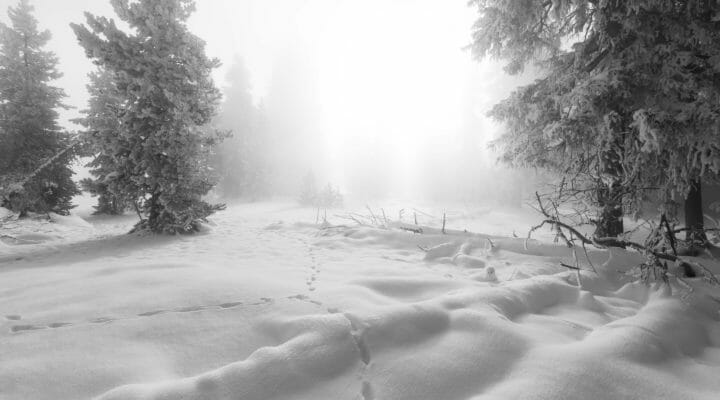
See Wolves in Yellowstone
Explore the Greater Yellowstone Ecosystem in search of wolves in summer or winter. Every multi-day wildlife safari is led by a professional naturalist guide. A multi-day safari allows for more time in the field and a better chance of spotting elusive wildlife. Our experienced team of professional naturalist guides are well versed in the area and offer the best opportunities to find wildlife in its natural habitat. Our summer safaris cover Jackson Hole, Grand Teton National Park and Yellowstone National Park. Our winter wolf safari covers the northern range of Yellowstone National Park, where we are most likely to find wintering packs.

